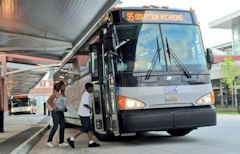by James A. Bacon
Virginia’s Department of Rail and Public Transit (DRPT) dishes out roughly $190 million a year in financial support to some 24 transit operations around the state, and that doesn’t include $50 million that goes to the Washington Metro system. Mark Aesch, CEO of the TransPro consulting firm, thinks that money can be spent more efficiently.
The current funding formula, which is based upon ridership and operating expenses, does not reward efficiency, Aesch told the Commonwealth Transportation Board (CTB) earlier today. “The discussion is about how to get more money rather than how to get better.”
But a soon-to-be-published report ordered by the General Assembly will propose creating a new framework for distributing state funds, Aesch said. Under a proposed hybrid formula, 50% of state funds will be allocated by the old formula while the other 50% will be distributed on the basis of performance criteria, such as:
- Customers per revenue hour (annual ridership/total annual revenue hours)
- Customers per revenue mile (annual ridership/total annual revenue miles)
- Financial success (percentage of operating costs recovered by agency-generated revenue)
The idea behind performance measures, said Aesch, is “to provide a public sector service with a private-sector mindset. Today, increased funding is tied to increased spending. There is no link to goals or performance.”
The preliminary report classifies transit companies — which vary from the massive Washington Metropolitan Area Transit Authority to the tiny Pulaski Area Transit — into six peer groups. State funds will be divvied up between peer groups and then distributed to agencies based on performance. There will be a three-year transition period to allow agencies to make the shift.
“For the first time, this introduces the concepts of quality and performance into the equation,” said Aesch. Other states are moving in the same direction but the enactment of the recommendations into law would put Virginia “at the forefront of the conversation.”
Among CTB members, Allen Louderback, a rural, at-large member, spoke in favor of the new direction. Many transit routes have low ridership that local governing bodies find difficult to cut for political reasons. “This will allow localities to make those changes and justify them. [It will] reduce the politics.”
However, the transit companies are less enthusiastic. Demand for transit services is increasing even as local governments are struggling fiscally, said Linda McMinimy, executive director of the Virginia Transit Association. “There’s a lot of concern about transit companies competing against one another for funds, creating new winners and losers.”
Formulas are beneficial, McMinimy said. They provide the predictability and reliability that transit enterprises need to plan their services going forward. Setting up an incentive pot is fine, she added, but the prospect of allocating half of all state funds according to performance is concerning to transit agencies.
The study doesn’t touch upon one of the biggest problems facing transit today, the unwillingness of some suburban localities to participate. In many locales, said McMinimy, residents of urban jurisdictions have no way to reach jobs in suburban counties located far from bus lines. Perhaps incentives could be created to spur participation, she suggested.
The final version of the report, along with draft legislation, will be submitted to the General Assembly September.



